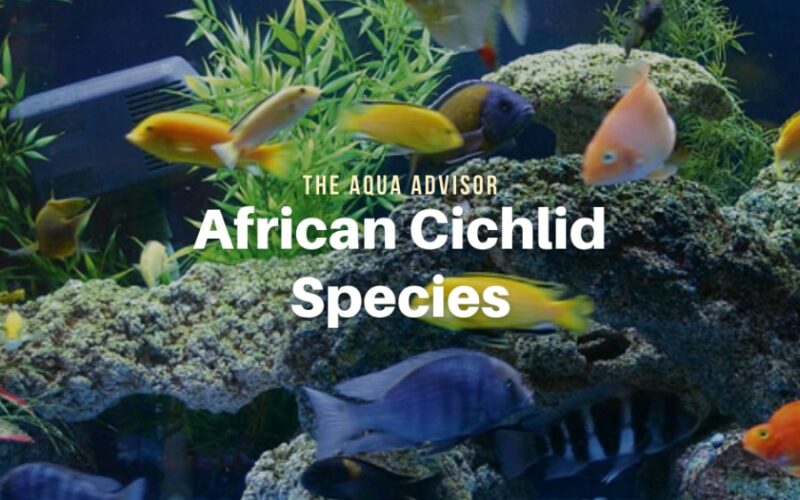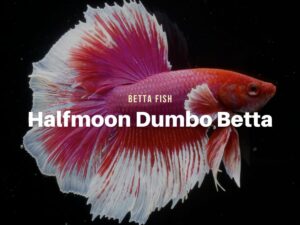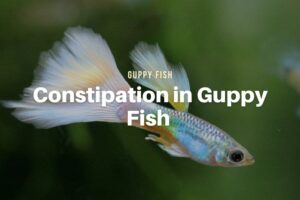African Cichlids are popular freshwater pets that originated in Africa. Compared to thousands of other cichlid species, this is one of the favorites among aquarists.
Each kind has different colors, characteristics, and temperaments that will add appeal to your freshwater tank.
In the wildlife, African cichlid can be found in water bodies such as lakes and rivers. With an extremely active nature, they are fond of swimming and foraging between rocks and around caves or diving into sandy floors.
One of the particular interests of this species is a wide range of colors and patterns to choose from. However, cichlids take up quite some time to develop their colors to the fullest. Not to mention the colors may be affected by the way you care for the fish.
It is also worth noting that each type of African cichlids has a different aggression level. Before placing them together in the same fish tank, it is essential to mind their aggressiveness.
Besides, they tend to be more aggressive than other tropical fish so you have to be careful when mixing them with other fishes.
When it comes to cichlid types, there are tons of species recognized in the wild but only a few of them are ideal as pets.
If you are interested to keep African cichlid in your freshwater tank then take a closer look at the following list.
14 Types of African Cichlid Fish
As mentioned, each cichlid has different characteristic traits, temperament, and aggression level.
It becomes essential to understand the African cichlid you are going to pet, so your tasks can be simplified.
Here are the ideal types of African cichlids to keep in your tank.
Peacock Cichlids
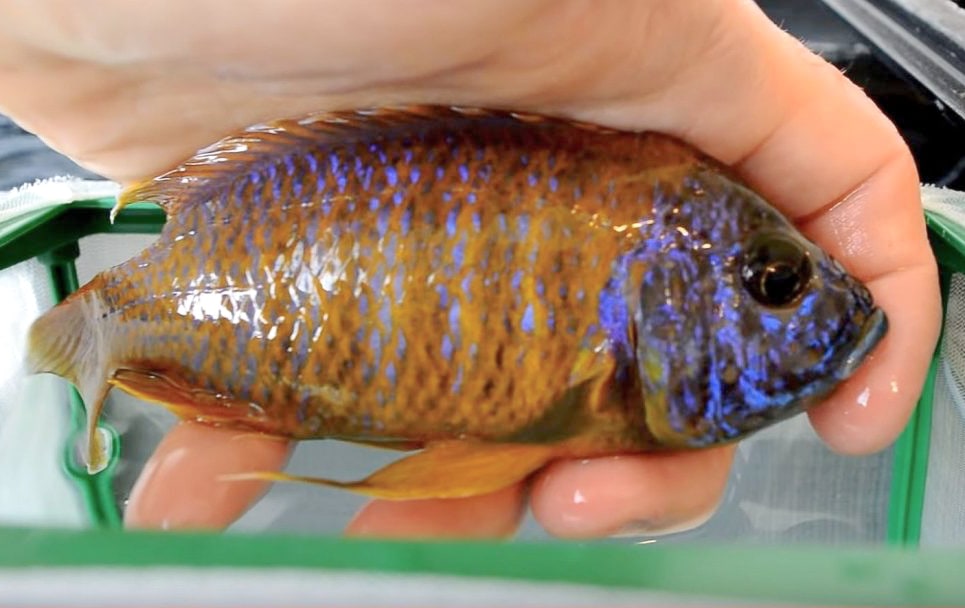
Peacock cichlids are characterized by their vibrant colors, making it visually attractive in the fish tank. They have vivid blue scales with markings that make them pretty much like a peacock.
Not surprisingly, this kind of African cichlid is highly sought after among aquarists across the globe.
Also known as African Butterfly Peacock, this species has a quite long lifespan up to 8 years.
Peacock cichlids are completely easy to care but they can be more aggressive than you thought. But when compared with other species, they are quite docile.
Found in Lake Malawi, it is essential to provide the fish with an appropriate environment that resembles their natural habitat.
For instance, you may need to add a layer of sand into the tank so they can hunt for food just like in the wild.
Red Zebra Cichlid
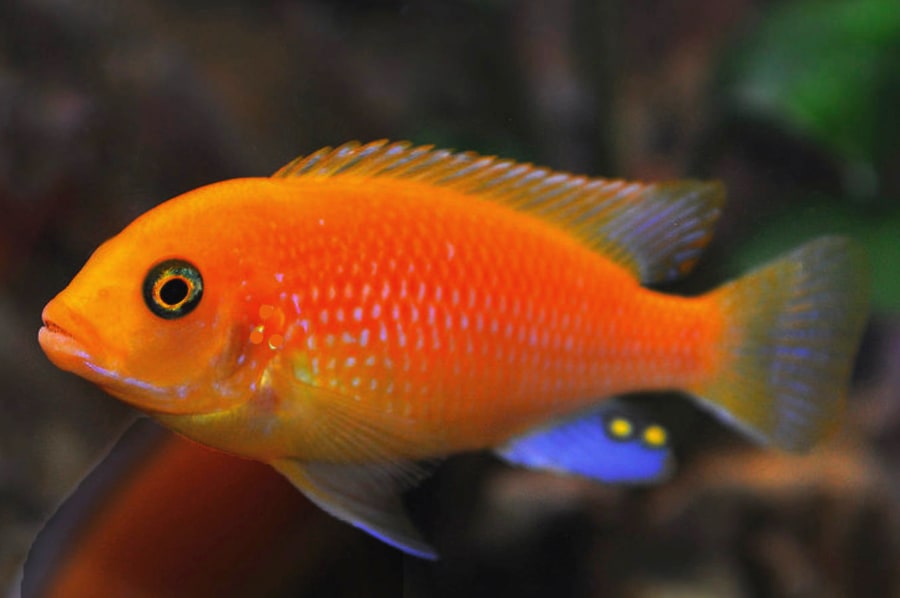
Despite their aggressive nature, Red Zebra Cichlid is an ideal pet for aquarists.
This kind of cichlid has an attractive bright coat that will add appeal to your aquarium. But considering their aggressive traits, you may want to keep it in a separate tank.
Red Zebra is extremely territorial so it is essential to set your aquarium to mimic cichlid’s natural environment.
You may also need to provide a tank with structures like crevasses, rocks, and pyramids so these fish can mark their territory.
What’s interesting is, Red Zebras are matriarchal. Though this trait is rare in the animal kingdom, it makes your aquarium unique.
Bumblebee Cichlid
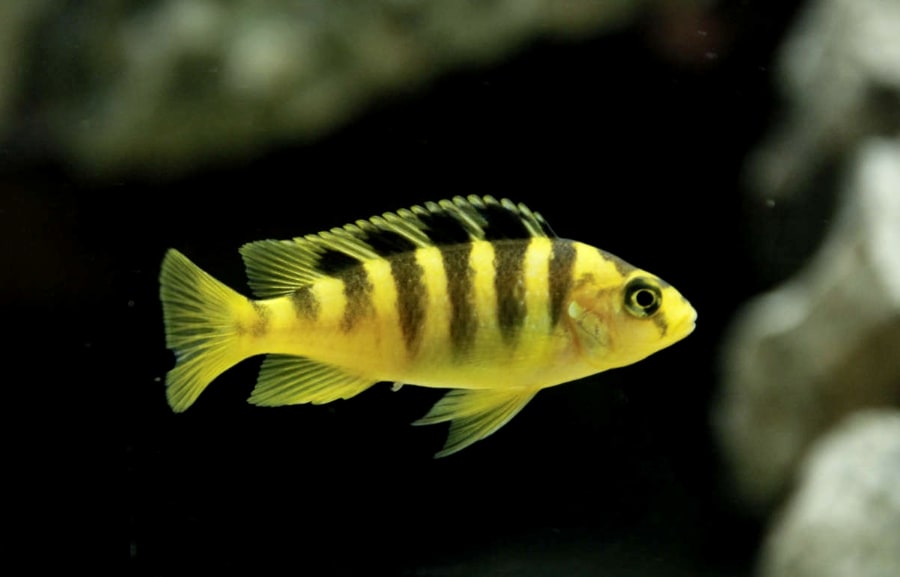
Bumblebee is one of the types of African Cichlids that will enhance your freshwater tank.
Found in caves in Lake Malawi, it has a black, tan, and yellow color. That’s why it is also called Chameleon Cichlids. Though it is ideal as a pet, caring for Bumblebee can be a bit of a task.
Not only is it aggressive in nature, it also requires special water conditions. When you decide to bring it home, it is very important to provide highly alkaline water.
There are some different methods to maintain ideal water for Bumblebee, but the most effective is adding laterite substrate into your tank.
To mimic their natural habitat, you may also need to add crevasses, rocks, and other structures. This kind of fish can survive for 10 years in an ideal environment.
Electric Blue
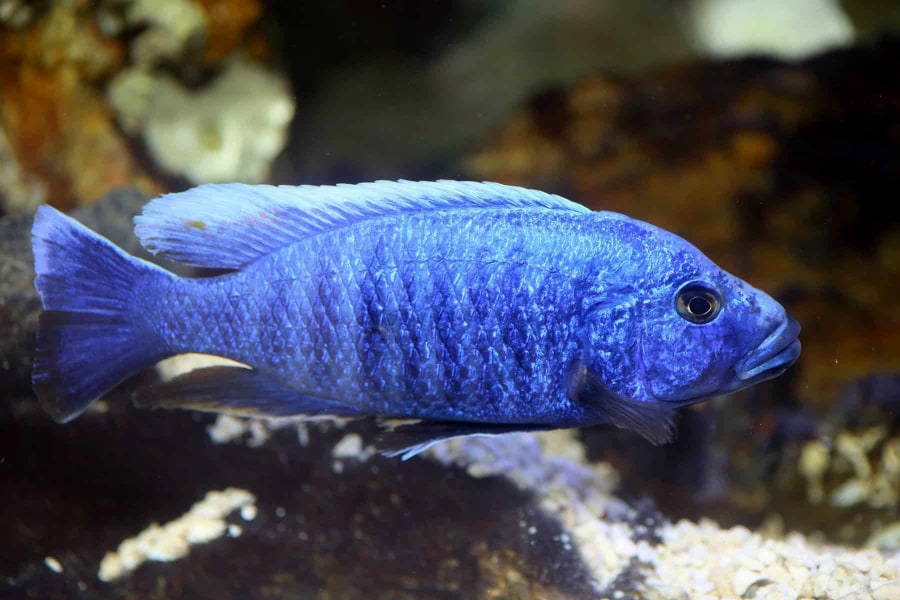
There are two different electric blue, Sciaenochromis Fryeri and Sciaenochromis Ahli. According to Aaron A Koning -famous aquatic researcher, Fryeri is commonly found lake wide, but Ahli can only be found in the northern regions.
Electric Blue is an omnivore, aggressive cichlid with magnificent colors.
As the name suggests, it has an appealing blue coat that looks amazing when swimming around in your tank.
Pretty much like other varieties, Electric Blue Cichlids are completely territorial. They forage through the aquarium to keep other fishes away.
So if you plan to keep this cichlid at home, be sure to place them in an individual tank.
Having that said, caring for this fish is quite easy. With good care, an ideal environment, and an excellent diet, they can survive for up to 10 years, making them one of the cichlid species with a long lifespan.
Frontosa Cichlids
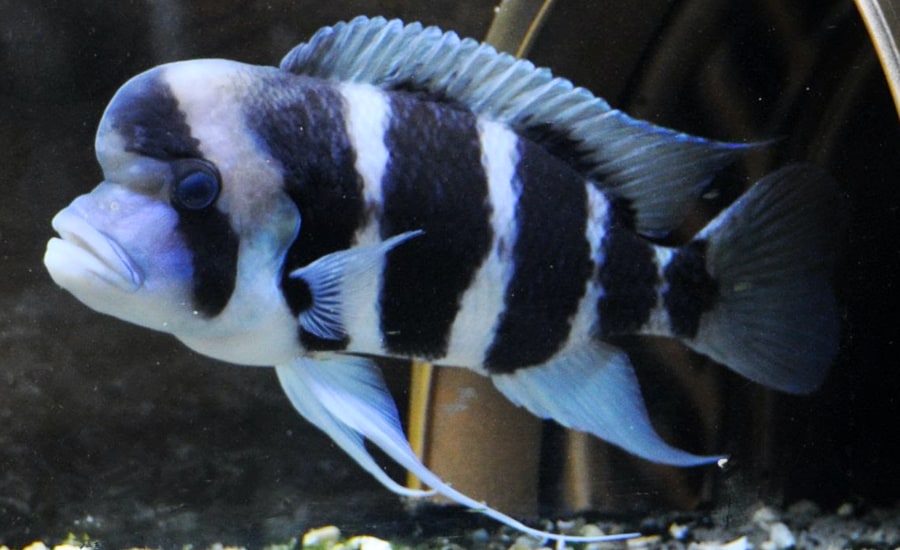
Africa’s Lake Tanganyika is home to beautiful fishes, including Frontosa Cichlids. This fish is characterized by a huge hump that grows when they are mature, serving as a distinctive feature.
It also has a unique tan and white color with black markings that make them visually attractive. The semi-aggressive cichlid requires a warm water temperature between 72 and 82 degrees.
If you are looking for docile fish that lives longer, Frontosa can be a good choice—it has a long lifespan of up to 25 years. It has a moderate care level which means you need to put extra effort into it.
In the wildlife, Frontosa lives in the deep water and it loves rocks and sandy bottom. Set your freshwater aquarium to resemble their natural habitat, so these fish can live happily.
Providing ideal water conditions, including pH and hardness is also a great way to keep them healthy.
Demasoni Cichlid
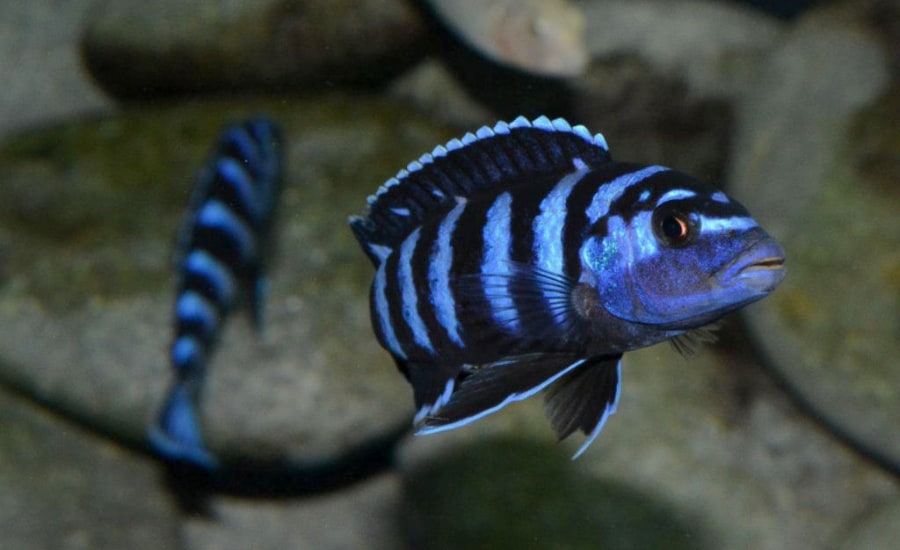
Featuring a striking coloration, Demasoni Cichlid is among aquarium favorites. It has a unique coat with white, black, and blue color that will look amazing in your tank.
Found in a lesser-known place Pombo Rocks, this kind of cichlid can be a unique species to pet.
Unlike other cichlids, Demasonis are semi-aggressive herbivores. Hence, it is quite safe to mix this fish with other docile species.
It loves to forage among rocks, not to mention it is fond of sandy bottom. You will find them diving into sand layers for food.
With up to 10 years of lifespan, Demasoni Cichlid is pretty easy to maintain.
Simply maintain ideal water condition with the warm temperature and provide rocks, caves, as well as sandy bottom so they won’t get stressed in the tank.
Kribensis Cichlid
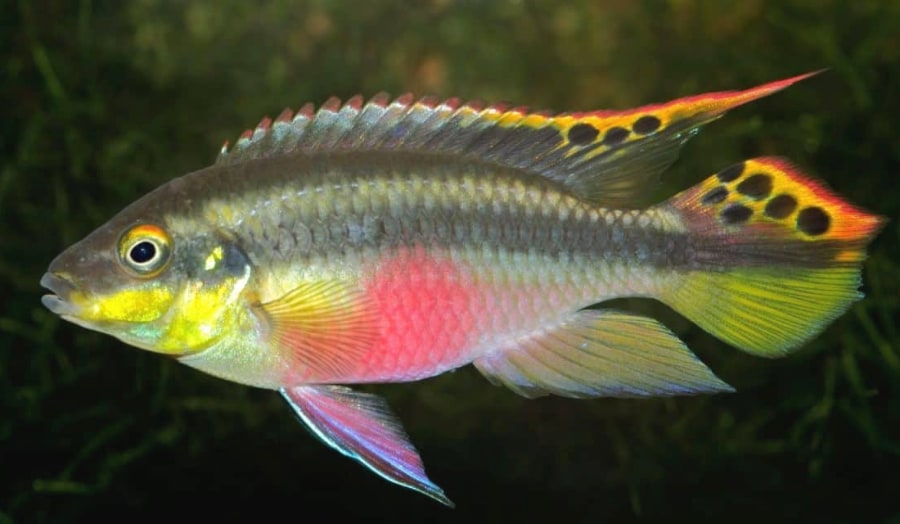
Coming from Western Africa, Kribensis Cichlid is a great option if you focus on breeding.
They are ideal for home aquarium, not only because they are pretty docile but they also have the ability to change colors as they are mature.
Compared to other cichlids, Kribensis are smaller in size, which becomes a reason why they are also called Dwarf Cichlids—this species doesn’t grow any bigger than 4 inches.
The omnivore lives in warm waters with an ideal temperature between 72 and 82 degrees.
With their small sizes, Kribensis Cichlids can live well in a 50-gallon tank.
In order to reduce stress, you may want to set the aquarium to mimic their wildlife habitat. Add plenty of caves and rocks so they will be happy in their new place.
Venustus Hap
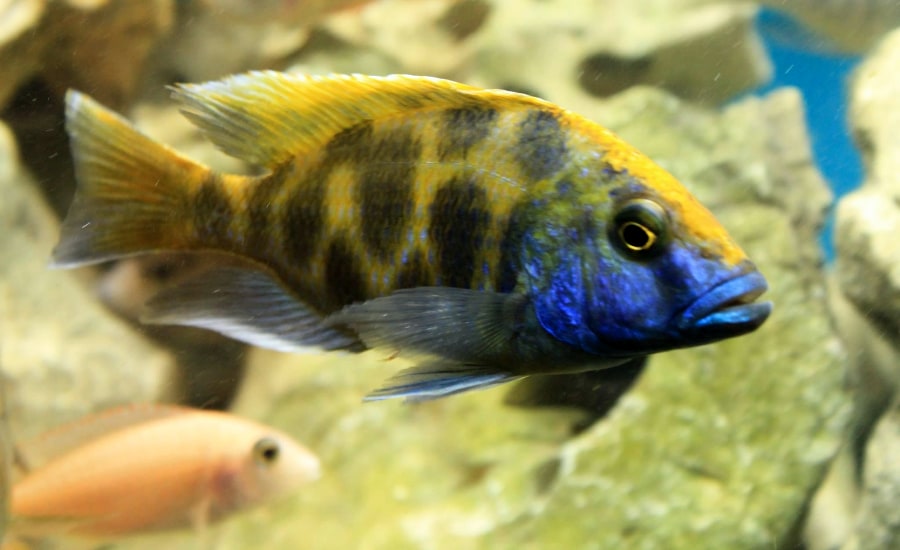
If you are looking for a cichlid with a flashy coat then Venustus isn’t your option.
This species has a distinctive white and blue coloration that makes a nice addition to your freshwater tank. Males also sport a blue face with yellow markings which look attractive.
Venustus Hap needs ample room to swim around and forage. You may also need to add some rocks and caves so they can play in the structures and feel homey in their new tank.
What’s important, it is essential to add sandy aragonite substrate to maintain an ideal pH level for this African Cichlid species.
Also read: Recommended plants for your sand aquarium
Also known as Nimbochromis venustus, this fish has a moderate lifespan of up to 10 years, provided you take good care of them.
Since Venustus Hap is aggressive, it is highly recommended to keep them in a separate tank.
Electric Yellow Cichlid
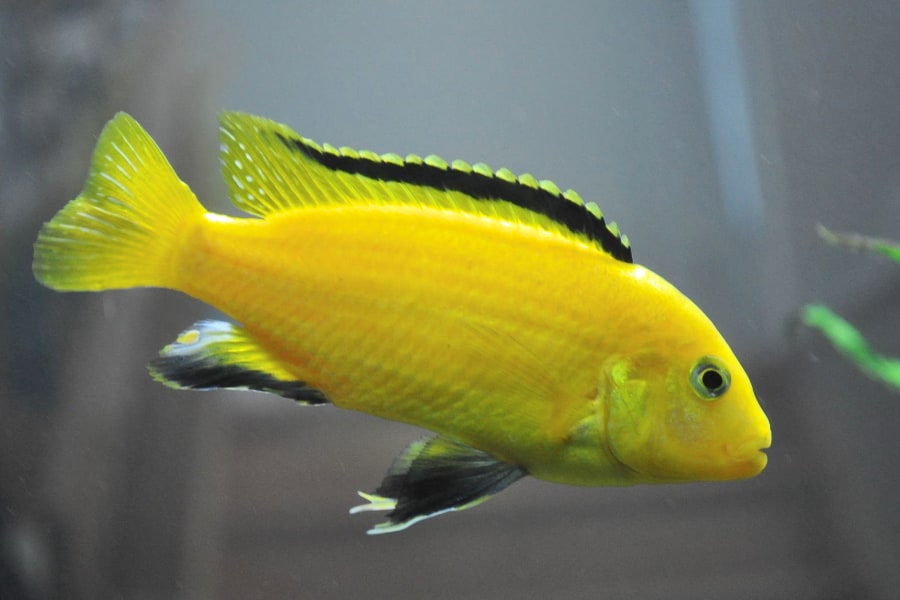
Having a vibrant yellow body coat, this kind of African Cichlid is visually appealing. They develop contrasting black stripes as they mature, making it more attractive for aquarists.
This species is originating in Lake Malawi and it has been an aquarium favorite, thanks to its adorable physical appearance.
Quite similar to other cichlids, Electric Yellow showcases territorial behaviors that cause them to be aggressive.
If you plan to keep them in home aquarium, make them feel comfortable by maintaining ideal water conditions and environment.
Electric Yellow Cichlids thrive in waters with warm temperatures, somewhere between 72 and 82. Being one of the small varieties, a 50-gallon aquarium will be just fine to keep them.
Duboisi Cichlid
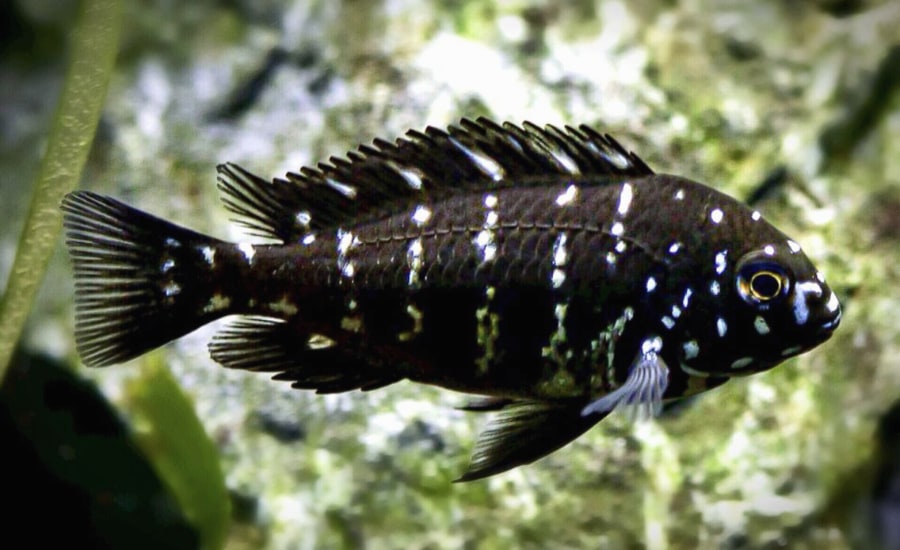
Originating in Northern Lake Tanganyika, Duboisi is an amazing cichlid with an adorable body coat.
Their coat keeps changing throughout their lives, and it starts with a black body and white spots. When they are mature, they will have a distinctive bluish face.
Duboisi is among small cichlids that won’t grow more than 5 inches, making it ideal for smaller tanks.
A 50-gallon aquarium will be sufficient, but since they have a territorial behavior then it is important not to keep too many of them in the same tank.
With 7 to 10 years of lifespan, Duboisi can be an option for aquarists. To make them thrive, maintain ideal water pH, temperature, and environment. Adding rocks and caves will help them adapt faster in their new home.
Kenyi Cichlid
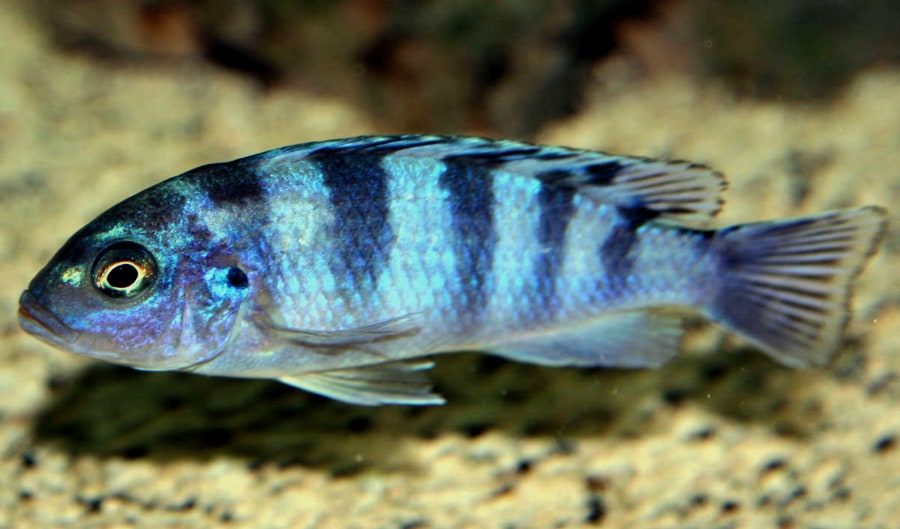
Known for their high temperament, Kenyi Cichlid is an ideal choice for aquarists who want to keep aggressive fish.
Because of the same reason, you may want to think twice before adding other fish into the same tank as Kenyi.
This species is found in Lake Malawi and it showcases a beautiful body coat with black, white, and yellow color.
They prefer rocky habitats, so including rocks in your tank will help them thrive. They also love to hide, so adding some holes will make your tank a great place to keep them.
As a small herbivore, Kenyi fits well into a 50-gallon aquarium. With proper care, they can survive up to 10 years or more.
Acei Cichlid
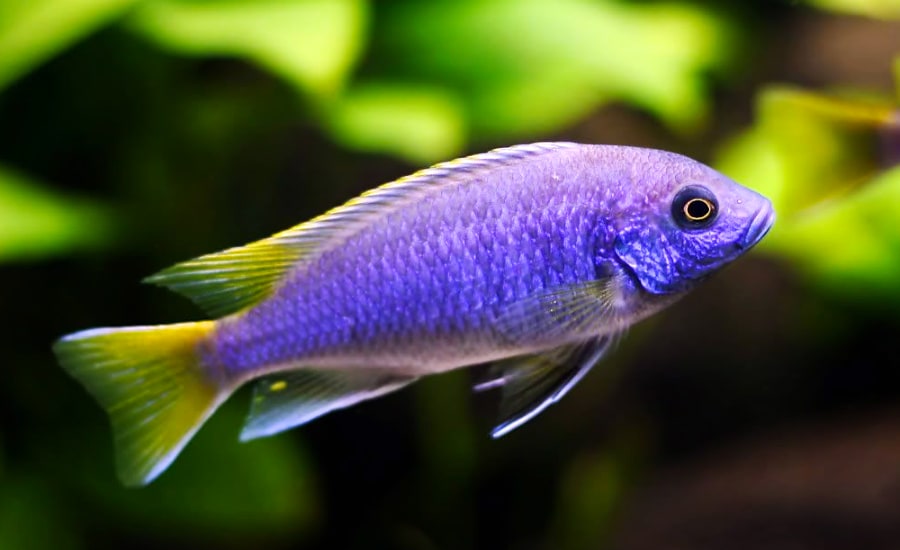
Lake Malawi is home to fantastic wildlife. Tons of fish species can be found in this water body, including Acei Cichlid can be distinguished from its blue and black body coat as well as yellow fins.
They are small in size but they love to swim around, so they require a larger tank.
In the wild, Acei Cichlid prefers caves and rocks habitat. That means if you want to make them feel at home, don’t forget to set some rocks and caves in the tank. Maintaining warm water temperature is also essential to make them happy.
When it comes to temperament, Acei is categorized into semi-aggressive cichlid. You have to be careful before deciding to add some other species to the same tank.
Brichardi Cichlid
Also known as albino cichlid, Brichardi is extremely popular among aquarists for it features elongated tails that look stand out. Only a few albino species are found in wildlife, so having one must be a privilege.
With a moderate care level, Brichardi only thrives in ideal water conditions. It is essential to maintain the alkalinity and hardness, not to mention they are very sensitive to changes.
You should also remember to set the aquarium heater between 72 and 82 degrees, which is ideal for them.
Additionally, it is worth noting that you shouldn’t add real plants into the tank because these fish are known as professional diggers.
A 30-gallon will be enough for this species, so you don’t have to invest in a large home aquarium. You can expect to see territorial behavior, especially during the mating season.
Final Words
In a nutshell, there’s a long list of species when it comes to African Cichlid.
As different type of cichlid has different characteristics, temperament, and maintenance requirements, it is highly recommended to learn about the species before bringing them home. That’s is the most responsible way to keep them as a pet.
